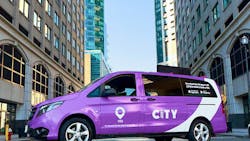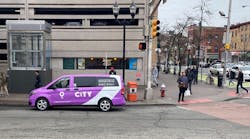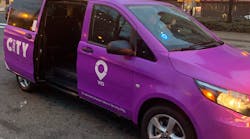In the spring of 2019, Jersey City Mayor Steven Fulop had a problem. Bus route cuts in Greenville, a neighborhood south of downtown, brought the longstanding issue of transit access in outlying Jersey City neighborhoods to a crisis. Largely communities of color, these areas saw their affordable transit options dwindle. On the lookout for alternative solutions, Mayor Fulop tasked his team with exploring what kind of transit options the city could administer directly.
Via Jersey City launched in February 2020 and, four years later, this city-run microtransit service has delivered 2 million rides. It has established itself as one of the nation’s most successful programs of its kind in terms of ridership, efficiency and social impact, with 80 percent of rides serving people of color and 60 percent serving low-income residents. Communities across the state have taken notice, as a successful microtransit service targeting workforce development launched in Camden, N.J., in July 2023, while a service in Middlesex County set to launch in March 2024.
A success story for Mayor Fulop, Via Jersey City also serves as a blueprint for cities and other local governments looking to deploy microtransit without the assistance of an established transit agency or city transit department. Four years of microtransit in Jersey City have yielded three insights relevant for cities looking to take transit into their own hands.
1. Connecting people to opportunities
Before microtransit’s launch, Via’s data scientists estimate that only 20 percent of the city’s jobs were accessible within 30 minutes’ travel on bus and light rail alone. Now, microtransit has made it possible to reach more than half of the city's jobs within 30 minutes, especially when it’s used as a first- and last-mile solution to connect to existing fixed-route service. Microtransit also creates jobs, as 60 percent of Via Jersey City’s monthly active drivers are from the city itself and 20 percent are from its surrounding towns in Hudson County.
The service has also expanded access to affordable housing. Data shows that 40 percent of all rides started or ended within 300 feet of an affordable housing location. By growing transit access, the city ensures that its most vulnerable residents not only have an affordable and safe place to live, but can also move to their desired destinations.
2. Serving those who need transit the most
There's a misconception that tech-enabled transit programs can be as expensive as other single-occupancy ride hail services, inaccessible to riders with disabilities or exclude passengers who don't use a smartphone.
However, services like Via Jersey City are designed with equity on top of mind. With its affordable fares, wheelchair-accessible vehicles and an option for call-in bookings, it has successfully provided transportation to those who need it the most. Of riders surveyed:
- 60 percent report an annual household income less than $50,000.
- 67 percent do not have access to a personal car.
- 80 percent identify as people of color.
- 85 percent use the service for essential needs.
- 13 percent report having disabilities.
3. A strategic approach to funding delivers long-term financial sustainability
Traditional transit agencies have a number of local, state and federal funding options available to them for funding fixed-route transit and, increasingly, tech-driven solutions such as microtransit. For city governments, the path to funding may be less clearly drawn but there is still a wealth of opportunities available.
Via and Jersey City have collaborated on several creative funding strategies for long term economic sustainability. Federal and state grants have been a cornerstone of the strategy. Via Jersey City was initially supported by the Federal Transit Administration’s Job Access and Reverse Commute Program, designed to fund transit options for lower-income workers. The city’s commitment to including electric vehicles in the service’s fleet led to an additional opportunity: A New Jersey Department of Environmental Protection grant for charging infrastructure.
Via Jersey City also generates additional revenue from vehicle-based advertising in the form of roof “toppers” and in-vehicle screens. This revenue stream defrays ongoing operational costs and scales up as the service grows. Via and the city continue to explore new avenues for funding, including additional grant opportunities and corporate partnerships, to ensure that no eligible money is left behind.
Looking forward
A few years after launch, the landscape for on-demand microtransit looks very different. The mode has expanded worldwide, with more than 300 services launched in 2023 alone. Perception of microtransit as a viable component of a transit network — one that transit planners and consultants now regularly include in network redesign projects — is, in part, the result of the encouraging data coming out of places like Jersey City. The city has been a strong leader through a very difficult time in public transportation.





